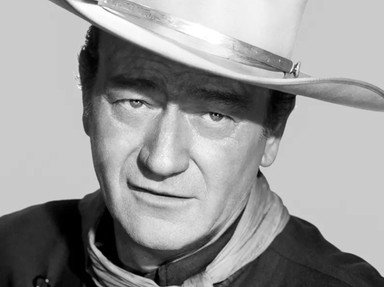Quiz Answer Key and Fun Facts
1. Though he had been a leading man in B-movies since the ambitious failure of his first starring role (1930's "The Big Trail"), John Wayne's first major success as an actor was his performance in John Ford's seminal 1939 western "Stagecoach". Prophetically enough, the Duke's character, Ringo, found himself in love with a soiled dove by the sobriquet of Dallas. Who played Dallas in this great film?
2. As "Stagecoach" opens, Dallas is being summarily run out of town by the Law and Order League, presumably for plying her trade. Which character is being expelled from the municipality along with her?
3. Throughout "Stagecoach", Ringo, though noble, is not the most cerebral character, and he remains blissfully unaware of Dallas' déclassé career until the film's denouement. How does Ringo discover Dallas' profession?
4. John Wayne's second film with John Ford was another ensemble piece, the merchant marine drama "The Long Voyage Home". The Duke plays Ole Olson, an amiable seaman trying to return home after a succession of voyages that habitually conclude with him getting drunk and losing his pay. After the end of the combat-pay job in this film, however, it seems that Ole really will get home. Standing in his way, however, is a lady of the evening (Freda by name) working with a corrupt sea crew looking to shanghai the big Swede. What distinctive drink does Freda (played by Mildred Natwick) drug in an effort to kidnap the homeward-bound sailor?
5. In 1949's "The Sands of Iwo Jima" John Wayne plays Sgt. Jack Stryker, a seemingly hard-hearted platoon leader who, as the film progresses, reveals a complexity to his character in ways both noble and dark. At one point in the film, Stryker goes home with a woman who, it is strongly hinted, is a courtesan. The encounter is halted, however, when Stryker realizes that she is in the business to support her baby. Stryker concludes the evening by helping prepare the baby's formula, contributing some currency without recompense, and discreetly excusing himself.
6. 1957's "Legend of the Lost" finds John Wayne playing Joe January, a guide for a missionary Paul Bonnard (Rossano Brazzi) on a treasure hunt into the Sahara desert. What screen legend plays Dita, a street girl who follows the two men in search of redemption?
7. At the outset of "Legend of the Lost", Dita despises Joe January - her occasional customer - for the abusive and dismissive way he has treated her. On the other hand, she idealizes Paul Bonnard - who has refused her services - for the moral redemption his way of life offers. Does she come around to the Duke's character by the movie's end?
8. 1960's "North to Alaska" features John Wayne as successful prospector Sam McCord and the strikingly beautiful Capucine as the paid companion Michelle. Although McCord meets Michelle in a Seattle house of ill repute, he is not initially interested in her amorously. Why not?
9. 1963's "McLintock!" sees the Duke, playing the title role, separated from his wife Katherine, played by frequent collaborator Maureen O'Hara. Early in the film, Katherine arrives in the cattle town that bears her husband's name, intent on securing a divorce and taking their daughter (played by a young Stephanie Powers) back to the East Coast. As the film progresses, however, it becomes obvious that the two still have feelings for each other. Katherine is loathe to admit this, largely because she is suspicious of her husband's relationship with his cook Mrs. Warren (Yvonne De Carlo) and "soiled dove" Camille (Mari Blanchard). Katherine "makes nice" with Mrs. Warren, who ends up marrying the local sheriff, but does not so reconcile with Camille. How does Katherine retaliate against her less respectable rival?
10. One of John Wayne's last films, "Rooster Cogburn" saw the Duke reprise his Oscar-winning role as the eponymous sheriff. Starring opposite John Wayne was Katherine Hepburn, playing a madam who commissions Rooster to "look after [her] girls".
Source: Author
stuthehistoryguy
This quiz was reviewed by FunTrivia editor
skunkee before going online.
Any errors found in FunTrivia content are routinely corrected through our feedback system.

